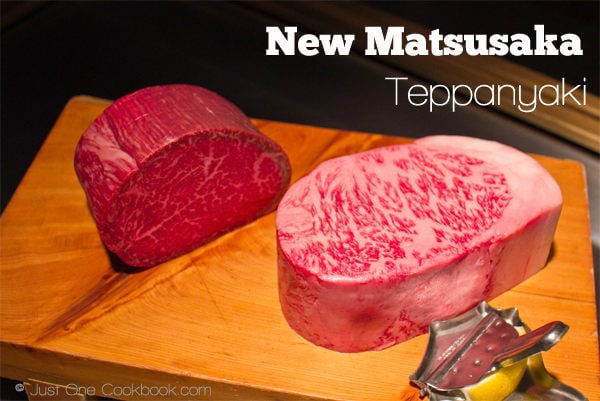 Dear readers,
Dear readers,
It’s been awhile since we’ve written a restaurant review on Just One Cookbook so we’re very excited to share this review with you. Before I jump into the restaurant review, I want to share my thoughts on the amount of effort the Japanese dedicate into refining their food.
Every time when I visit Nami’s family in Japan and stop by the department stores’ food plaza, I love going from stall to stall just admiring the various food inside the glass display. Everything looks super delicious, from cheesecake to Japanese rice crackers and each one is placed perfectly in its own unique packaging inviting you to take it home. If I had my way I would probably camp out at the food plaza for an entire week trying everything. It’s evident even from these casual food stalls that the Japanese puts in tremendous effort to deliver what they consider the best product possible.
The spirit and commitment to food excellence is present everywhere and the number of Michelin star restaurants in Tokyo (266) and Osaka (243) area speak for themselves (there are more Michelin star restaurants in Tokyo than all of the US cities combined). Even at local neighborhood restaurants, it’s impressive how much effort they put into their food and service to make sure their customers have the best possible experience.
Japan’s passion for food aren’t just experienced when dining in restaurants, but also communicated through popular TV food shows like Iron Chef and Dotch Cooking Show. Watching these shows, they are very entertaining yet impressive how much the effort the chef puts into refining simple dishes such as curry or tonkatsu to prepare the best possible dish. If you have never seen an episode before, there are a few episodes on YouTube. Sometimes the refinement does go a bit far, such as $50-$100 dollar Yubari melon (cantaloupe). Speaking of refinement, one Japanese ingredient that is world renowned for its quality is the super premium Japanese beef (Wagyu – translates to cow raised in Japan).
During our trip to Japan, we had the chance to dine at New Matsusaka, a traditional teppanyaki restaurant, literal translation “grill on iron plate” and enjoyed this super premium beef.
Most restaurants in Japan that serves branded premium beef (such as Kobe, Matsuzaka, or Yonezawa beef) would usually display the heritage and certificate of each cattle as you enter the store. Information includes who the farmer is, where the farm is located, what is the grade of the beef, and when the calf was born as well as how long the calf was raised. With other non-branded high end beef, usually each particular cattle is cataloged carefully and origination location detailed.
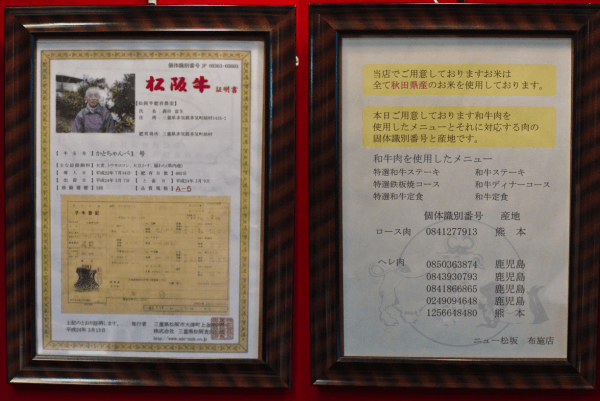
Many of you in the US are probably familiar with teppanyaki since Benihana introduced the cooking style in 1960’s. For those of you who are not familiar with teppanyaki, it is the style of Japanese cooking that prepares and cooks the food on a hot flat metal surface. The cooking surface is typically surrounded by guests seating around in a half circle allowing the chef to serve everyone from the center. The chef uses a flat metal spatula and a few other metal utensils to prepare and cook the food on the hot metal surface.
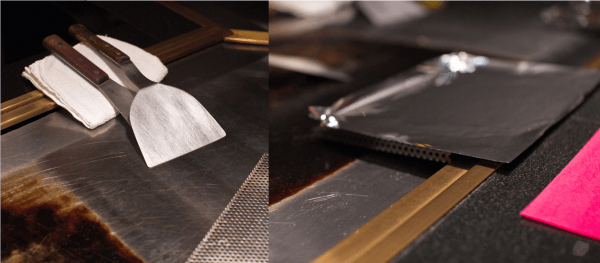
In front of each guest, there is a small metal plate that help keeps the food warm after the chef is done cooking. The teppan (iron plate) offers a wok charred taste that is very delicious to the palate. Grilling on teppan is different from a regular grill because all the juice stays on the cooking surface instead of escaping through the bottom. In the US, there is an emphasis for the chef to entertain the guests with trick moves at teppanyaki restaurants but that actually does not happen in Japan.
The meal started with stir-fry napa cabbage, and then followed with Japanese kabocha (pumpkin), renkon (lotus root), yomogi-fu (glutencake), and konnyaku (konjac). The grilled appetizers were also served along with a smoke salmon salad. The napa cabbage tastes similar to a wok charred stir fry cabbage and the soft texture of yomogi-fu contrasted the crunchy renkon very well.
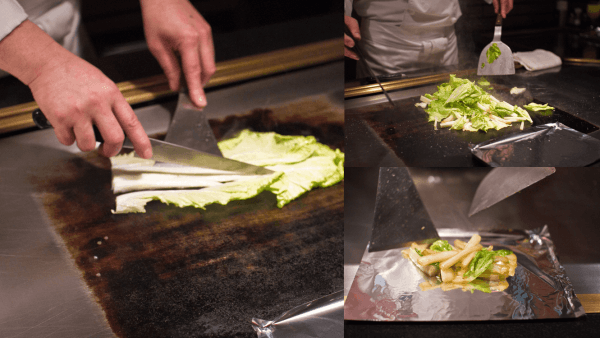

Then the main show started; we were in for a real treat. On the menu that night are live abalone and lobster. The lobster was cut in half, placed shell side down first then the meat side and steam cooked by sealing the vapor with a metal cover. The lobster meat was then taken out and cut into pieces for a bit more cooking. When done, it was served in its shell.
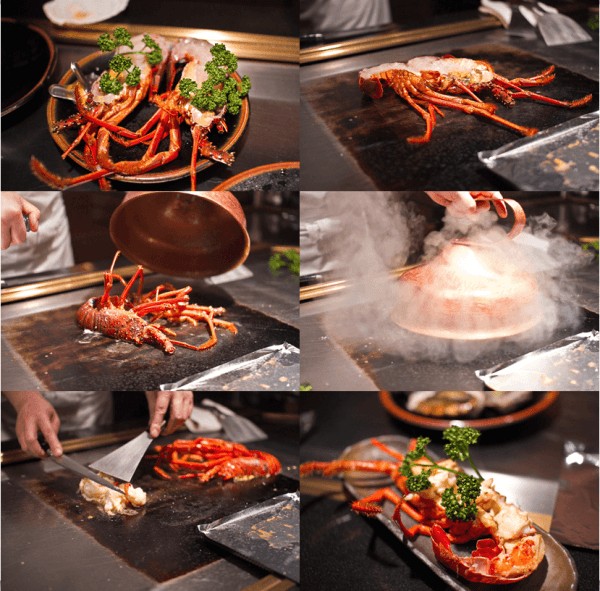
The abalone was placed open side down first which made them come off their shells rather quickly. The chef then removed different parts of the abalone leaving only the center muscle intact. To cook the abalone, he made diagonal crisscross incisions on both side and placed a piece of butter on top and covered with the shell. Needless to say, both the lobsters and abalone were super delicious leaving your mouth watering and wanting more after each bite. The lobsters shells and head were later used to make a savory miso soup so no parts were wasted.
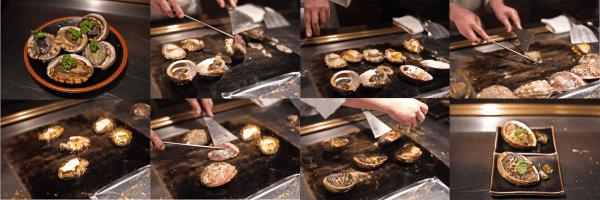
After the seafood courses, the restaurant made their specialty fried garlic for us. They get their high quality garlics from Aomori Prefecture which are extra-large. I had thought the fried garlic were made by simply throwing them into a deep fryer. My assumptions were way off, it actually took the chef about 25 minutes to slowly cook garlic on low heat to achieve that perfect color and taste (in Japanese they say similar to color of a fox(Kitsune Iro)).
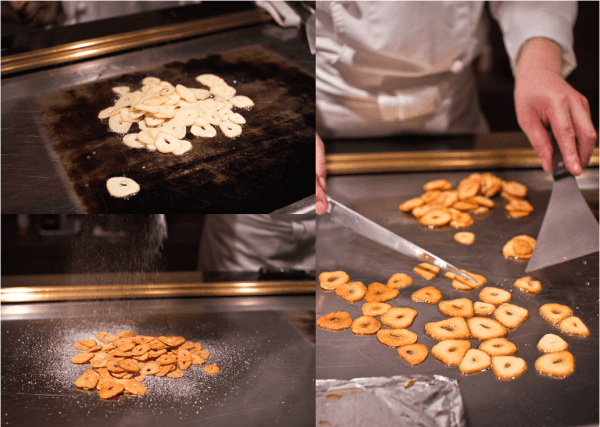
It’s now time for the beef course. We did not have the Matsuzaka beef that day but the special select “rōsu” (ロース/rib eye) and “hire” or “here” (ヒレ or ヘレ/tenderloin) were both extremely well marbled. The rib eye is typically much fattier than the tenderloin. Most steakhouse and tonkatsu restaurants in Japan offers two types of meat so guests can choose based on their preference.
The chef started by removing all the fat surrounding the beef and then browning all sides. The removed fat was slowly cooked and melted to use as the cooking grease. The rib eye was cut into 7 pieces and moved to the wooden board. For the tenderloin, he used the garlic oil to brown all sides and divided into 9 pieces. After the tenderloin were cut, the rib eye was further divided into 15 slices.
Each slice was cooked to perfection and the flavor was only slightly accented with the house special salt along with a bit of soy sauce. You can taste the sweetness of beef with each slice. The best way to enjoy beef at New Matsusaka is to place a few slices of fried garlic together with a slice of beef. This combination tasted like a bit like fireworks going off in your mouth, the beef is so soft and tender that it melts in your mouth yet the crunchy garlic offers a completely different texture and complexity to the flavor. Each person only had 3 slices of the rib eye but it was more than enough even for a meat lover like me. The experience was not unlike eating 3 small sticks of butter. The tenderloin was also excellent but not nearly as fatty as the rib eye so we had a few more slices each.
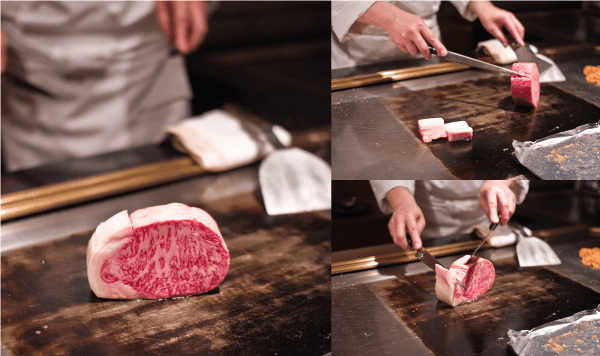

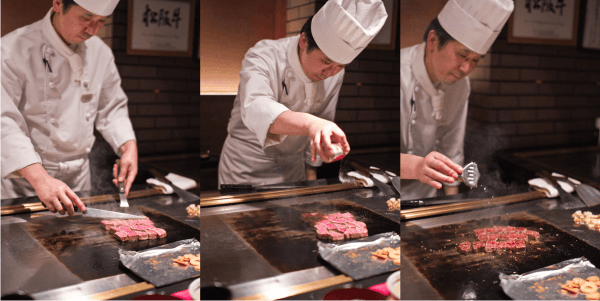
We had a lot of great meals in Japan but this particular one is going down in the history book as one of the best meals we’ve had. Each of the courses was cooked perfectly and it was a real treat. We look forward to going back again when we visit Osaka.
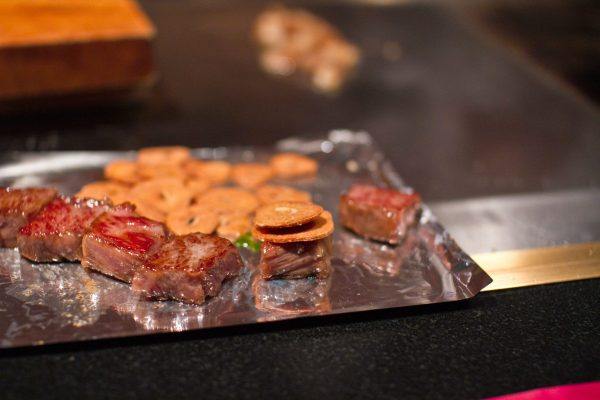
Full Disclosure: New Matsusaka was founded by Nami’s grandfather but has been sold since he passed away.
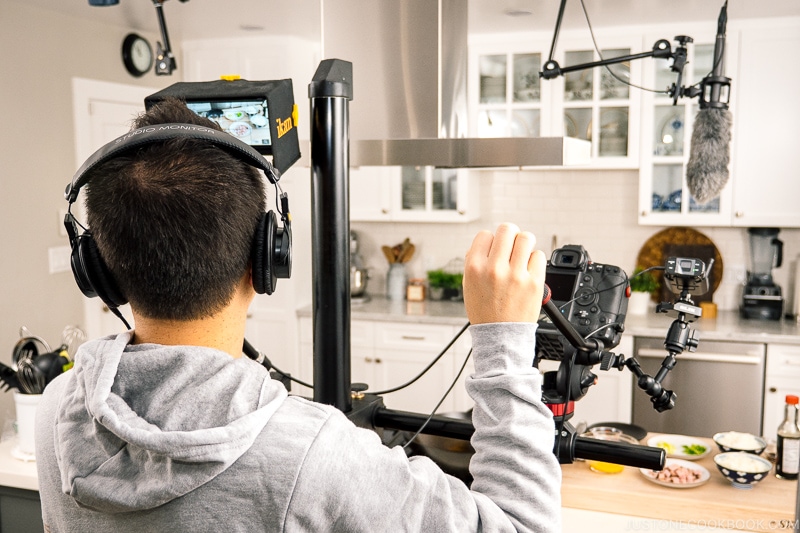









Oh Gosh, you’ve eating like an emperor there….
abalone, lobster and matsusaka beef in one dinner, i’m totally jealous!!!
ps: i won’t let the chef trimmed off the fat from the matsusaka beef, i wan’t it all actually
Hello Nami-san,
I have a question. I will be visiting Osaka late March and I’m definitely interested in going to this restaurant and trying Matsusaka beef (my father says it’s the best!) . I want to go there for lunch (the Umeda one), do you recommend reserving a table? Can you even reserve a table for lunch?
Thank you very much.
Hi Asami-san! It’ll be better to make a reservation because lunch time can be very busy in Umeda (三番街) store with all the salarymen. I hope you enjoy the meal. 🙂
Am I too late to give a comment? I might be going to Osaka soon, if I have time and chance, I wish to visit your grandpa’s restaurant. Any special recommendation or discount? Hehe…
Thanks for thinking about my grandpa’s restaurant (he passed away last year). Unfortunately, due to the management structure of the restaurant, I will not be able to give discount. I hope you get to visit the restaurant and try the food! 🙂
Sorry to hear that your grandpa was passed away. I will visit the restaurant if I have the chance.thanks for your recommendation.
Thank you for your kind words. 🙂
Love you’re recommendation. We planning to visit Osaka, Kyoto and tokyo feb 16. Can I get the web site of the new matsusaka restaurant. I am planning to make a reservation. Any recommendation for noodle, tempura and sukiyaki. Thanks for the help.
Hi Eunice!
The site is written in Japanese but here’s the link: http://new-matsusaka.com/.
There are two locations, but if you are in Umeda Statation, you should go to the one in Hankyu Sanbangai (三番街店 06-6373-3461).
Regarding other restaurants, I’m not too familiar with dining in Osaka area. Hope these links will be helpful:
Japanese: http://www.gnavi.co.jp/kansai/osaka/
English: http://www.osaka-info.jp/en/search/list/gourmet.php
http://www.tripadvisor.com/Restaurants-g298566-Osaka_Osaka_Prefecture_Kinki.html
Hope that helps. 🙂
Yum – this is a great review – I would love to visit Nami’s family restaurant when I go back to Osaka (one day soon I hope!). Great photos too!
Aww.. I’m happy to hear that you got a visit from the Fairy Hobmother!!
Nami what a wonderful treat you received, not just the second visit from the Fairy Hobmother, the Matsusaka Teppanyaki restaurant looks amazing. My mouth was watering everystep of the way! I can only dream!
Hi Shen, what a fantastic review! And what an amazing looking place, will have to go to the top of my “must visit list” 🙂